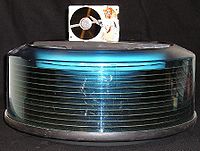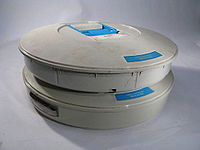Removable-pack disk
Removable-pack disks were magnetic disk mass storage peripherals which used removable packs (a group of one or more platters in a rigid assembly, which could be attached to the spindle of the disk drive) which could be installed in a drive, in a process called 'mounting a pack', and then later removed from the drive.
The method for attaching the pack to the spindle varied; in large multi-platter packs (such as the RM05 pack to the right) a handle built in to the cover was used to screw down a fitting which attached the pack to the spindle. In smaller packs, like the RK07 packs illustrated below, friction or magnetic means were used to allow the spindle to rotate the platter(s) in the pack.
In all cases, the pack came with a cover, which protected it (especially from air-borne dust, which could potentially cause a head crash) when it was not in the drive. In large multi-platter packs, this cover was typically removed after installing the pack in the drive to mount the pack; in smaller packs, part or all of the cover remained with the platter(s), and a hatch in the cover allowed the heads to reach in to gain access to the platter(s).
So a system could have multiple packs (for backup purposes, or for infrequently needed data) which could be stored until needed. Most early disk drives used removable packs.
Since a drive could be used with different packs, or a pack could be moved from drive to drive, the heads in such drives required very exact mechanical alignment (unless you did not care about being able to move packs from drive to drive; or being able to read the previous contents of packs written on that drive, after servicing the drive).
Early packs often had mechanical means to indicate where the start of a track was, when a pack was moved from one drive to another, such as a narrow slit cut in a ring on the base of the pack; the slit could be detected by an optical or magnetic detector. Later, one surface of one platter was dedicated to holding pre-recorded servo-mechanism control information.

